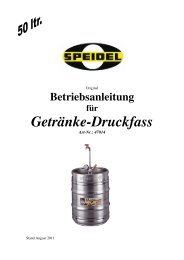Operating and brewing instructions 50l april 2008 - Speidel Tank
Operating and brewing instructions 50l april 2008 - Speidel Tank
Operating and brewing instructions 50l april 2008 - Speidel Tank
Create successful ePaper yourself
Turn your PDF publications into a flip-book with our unique Google optimized e-Paper software.
<strong>Speidel</strong>’s Master Brewer<br />
4.7 Cooling<br />
You must work in absolutely sterile conditions from now on because contamination<br />
that is caused by bacteria which are present in the air or on dirty equipment [e.g.,<br />
utensils] during all of the further working steps, can utterly ruin your work All of the<br />
equipment that is now used must be thoroughly cleans or disinfected as the case may<br />
be. Follow the advice in the section entitled “Advice about hygiene”.<br />
Before inserting the cooling spiral, we recommend vigorous stirring of the still hot<br />
wort using a long cooking spoon. This produces a so-called “whirlpool effect”, which<br />
assists the deposition of cloudy materials contained in the wort, thereby clarifying the<br />
wort.<br />
The cooling process primarily serves to cool the wort <strong>and</strong> to deposit the protein<br />
substances <strong>and</strong> hop constituents that have been separated during the boiling. These<br />
cooler sludge substances settle on the bottom slowly <strong>and</strong> they remain on the<br />
container’s bottom when the clear wort is drained off. Stirring or moving the cooled<br />
down wort should definitely be avoided because the deposited cooler sludge will be<br />
churned up again <strong>and</strong> runs off with the wort into the fermenting container. It is<br />
recommended to use a so-called wort cooler (a cooling spiral - refer to accessories) for<br />
cooling, which is placed in the wort immediately after the boiling ends <strong>and</strong> it must also<br />
be disinfected beforeh<strong>and</strong> because of that. The cooling takes place with hot water. The<br />
water that flows through the cooling spiral extracts heat from the wort <strong>and</strong> cools it<br />
down to the desired temperature of 20°C in 30 to 40 minutes. Caution: almost boiling<br />
water flows from the wort cooler’s outlet at the beginning (danger of scalding), which<br />
can be re-utilized for cleaning work later on. It is primarily important to achieve rapid<br />
cooling between 40°C <strong>and</strong> 20°C, when the wort is particularly susceptible to an<br />
infection. Take the cooling spiral carefully out of the tank when the wort has cooled<br />
down to 20°C <strong>and</strong> then allow the beer wort to flow into a disinfected fermenting cask<br />
via the stop cock (refer to accessories). However, approximately 6% (3 litres for 50<br />
litres of wort) will still be drawn off in a sealable container beforeh<strong>and</strong> <strong>and</strong> frozen<br />
afterwards. This wort will later serve as an additive to the fermented beer, in order to<br />
achieve a subsequent fermentation <strong>and</strong> sufficient formation of carbonic acid [i.e.,<br />
carbon dioxide] in the filled bottles. Use a suitable <strong>and</strong> clean hose or a hopper for<br />
bottling. The last litres will be decanted by tilting the Master Brewer carefully –<br />
provided that no cooler sludge flows with it into the fermenting container. The<br />
fermenting container or fermenting cask should be chosen to be distinctly larger than<br />
the amount of wort, in order to have adequate fermenting space <strong>and</strong> thus to avoid the<br />
fermenting foam from overflowing. The residue <strong>and</strong> the cooler sludge that are located<br />
on the Master Brewer’s bottom can be thrown away. The Master Brewer is not needed<br />
any longer now: please clean it as quickly as possible in order to prevent it from<br />
drying out <strong>and</strong> you will thereby ease the cleaning process considerably.<br />
4.8 Main fermentation<br />
The yeast is added to the wort after the cooled down wort has been decanted into a<br />
fermenting cask (a 601-PE cask with a stop cock - refer to accessories). Dry yeast is<br />
recommended for this purpose, which is easily added with the wort to the cask. You<br />
have to decide in this phase whether you want to prepare bottom-fermented or topfermented<br />
beer. Top-fermented yeast namely needs 15°C to 23°C for the fermenting<br />
process, whereas bottom-fermented yeast is active at 4°C to 12°C. The addition of<br />
yeast is thus dependent on each recipe too <strong>and</strong> from the desired kind of beer. Wheat<br />
beer <strong>and</strong> Koelsch are top-fermented sorts of beer. Maerzen <strong>and</strong> Pilsener are typical<br />
sorts of bottom-fermented beers. The alcoholic fermentation of beer is set in motion by<br />
Page 12 of 26
















